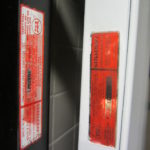There has been a lot of talk regarding school security vs. fire safety, and whether the need to secure doors during an active shooting tops the life-safety requirements of the fire codes. A couple of months ago I shared some statistics on active-shooter incidents vs. fires in schools, which showed that school fires occur much more frequently than school shootings. In the webinar recording that I posted yesterday, John Montes of NFPA stated that in Massachusetts (where NFPA is located) there were zero school shootings last year, and 336 school fires. Clearly, fire safety needs to remain a priority when considering locking devices and lockdown practices for schools.
 Last month, a high school in the Scottish Border town of Peebles was severely damaged by a fire that appears to have been started intentionally by students. Since then, the news reports about the fire have focused mostly on how to rebuild and what to do with the students in the meantime. But over the weekend an article appeared in The Scotsman:
Last month, a high school in the Scottish Border town of Peebles was severely damaged by a fire that appears to have been started intentionally by students. Since then, the news reports about the fire have focused mostly on how to rebuild and what to do with the students in the meantime. But over the weekend an article appeared in The Scotsman:
Peebles High School: Hero teacher had to ‘batter down’ fire escape door to rescue pupils
The article indicates that based on information from students and parents, several egress doors were locked as part of the school’s lockdown plan. Egress was reportedly delayed while a teacher located a code to unlock the doors, and at least one door could not be opened at all. Fortunately, there were no fatalities, but the outcome could have been much worse.
Here are some excerpts from the article:
- “The parent, whose child attends Peebles High School, also said some fire doors in the main school building which had recently been put on a new system keeping them centrally locked unless a fire alarm went off, did not open for several minutes.”
- “The parent claims other failings included Senior 1 pupils in the new PE block having to wait for a teacher to get a code to be input to open fire escapes and that the fire escape in the old PE block (directly next to where the fire broke out) could not be opened.”
- Another parent claimed the school was operating a ‘lockdown’ policy prior to the fire resulting in pupils and teachers being unable to get out of the building quickly and had to ‘funnel’ through a door leaving children screaming and terrified.”
- “During the fire, a minimum of three doors didn’t open. There could have been more. One of those doors had to be kicked open, another opened suddenly (which let out the mass of black smoke at once), and the third didn’t open at all. The third was only down the corridor from the fire.”
This is why doors in a means of egress need to allow free egress at all times – not only when the fire alarm is actuated.* The ability to evacuate building occupants quickly is a top priority. There are many products available that will meet the security needs as well as ensure compliance with the life safety codes and accessibility standards. Why compromise?
This drone footage shows the extensive damage caused by the fire:
*Although there are very limited exceptions to this rule (such as controlled egress doors serving a hospital’s memory care unit), the US model codes do not allow egress doors in schools to be locked in a way that requires staff to intervene before occupants can exit. For more on classroom security and safety, refer to this article from Door Security + Safety Magazine.
Photo: Scottish Borders Council
You need to login or register to bookmark/favorite this content.






Wow! This is so sad, and a thousand wonders that an excessive number of fatalities didn’t occur. No matter how many times you tell folks you can not lock doors, they do it anyway.
Donnie
Every time I’m in Europe, I notice things that would never fly in the USA. Double-cylinder deadbolts on apartment doors. A small (100 seat or so) auditorium with panic hardware on the exit, which leads to a lobby, whose final exit has…a double-cylinder deadbolt. How on earth are these things legal?
Matt,
You have to remember, there are buildings in Europe that were there before we were even a country.
And how often to buildings get re-inspected once they get a C of O?
Unless it’s a prominent public place, almost never.